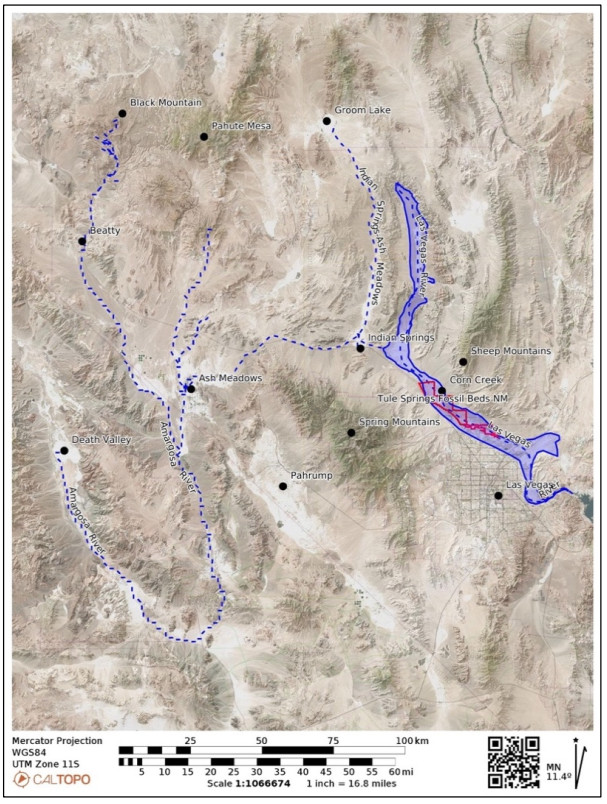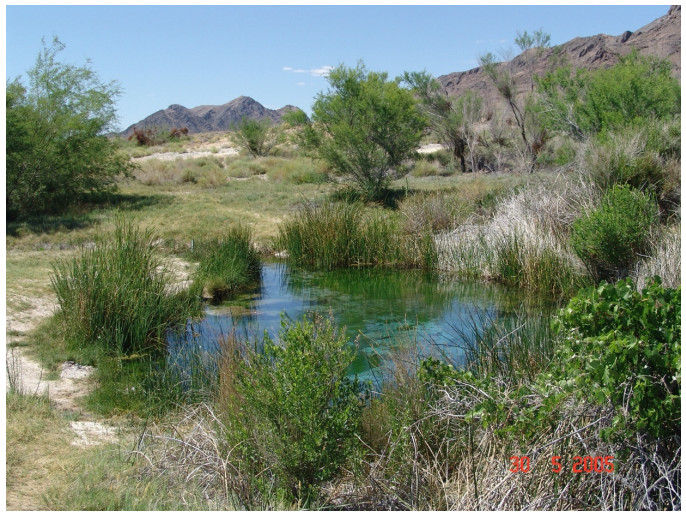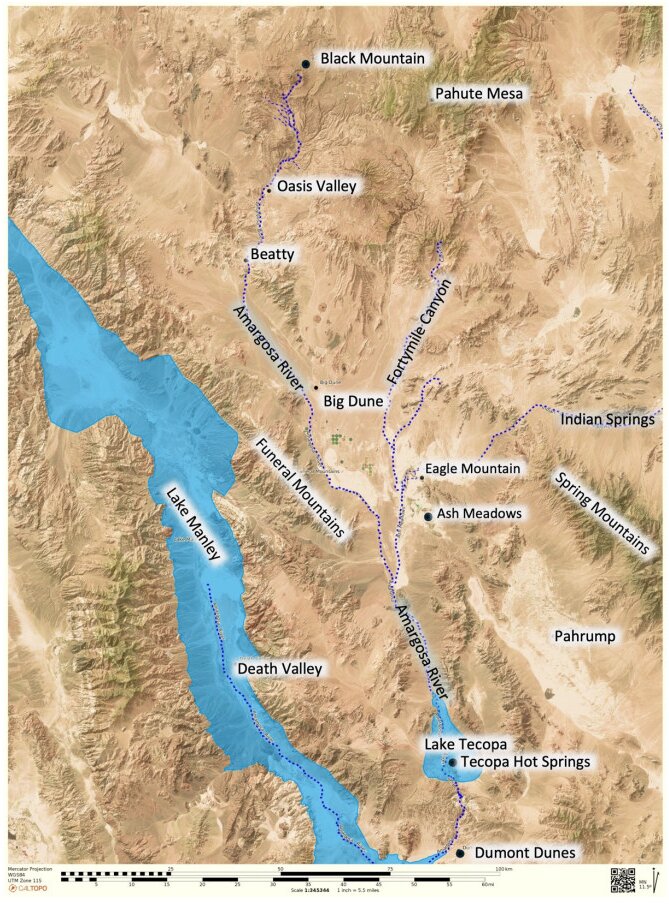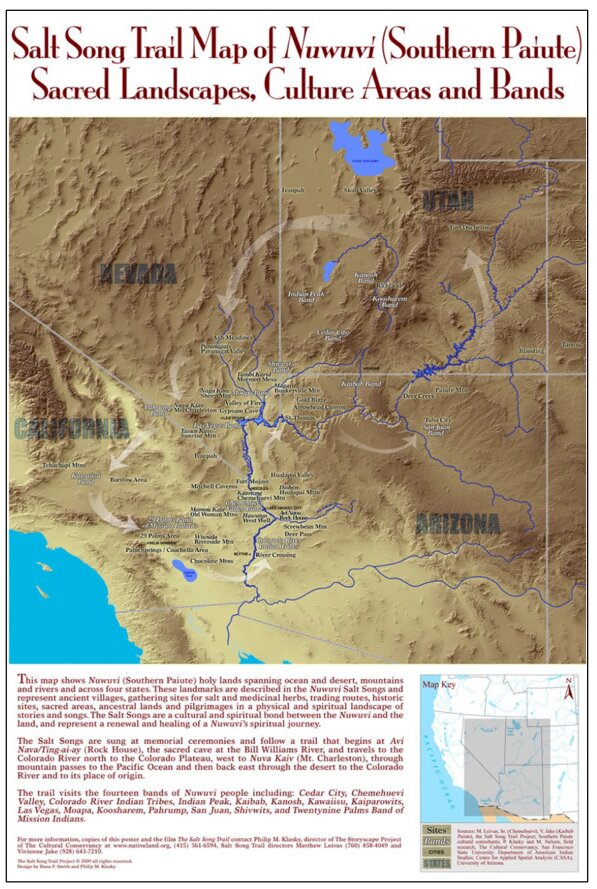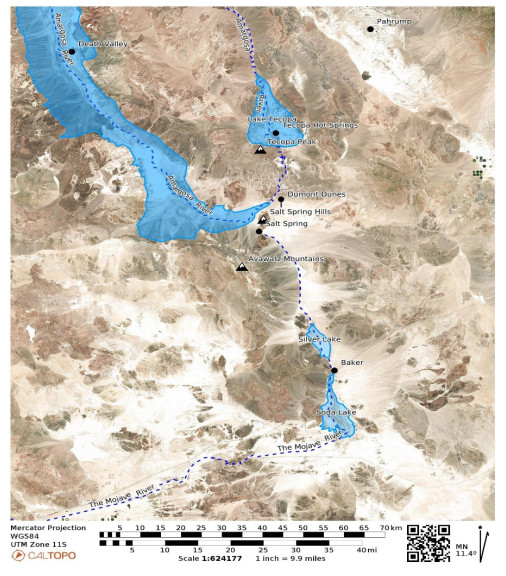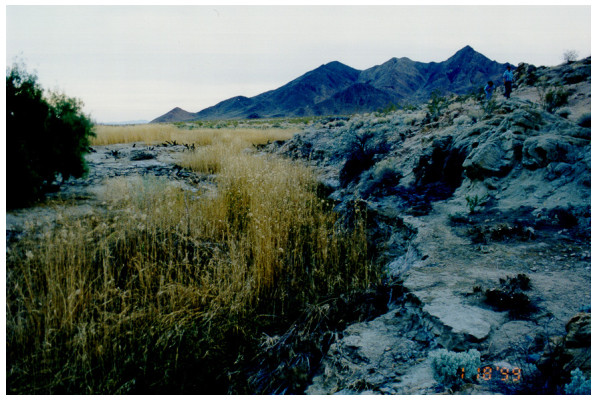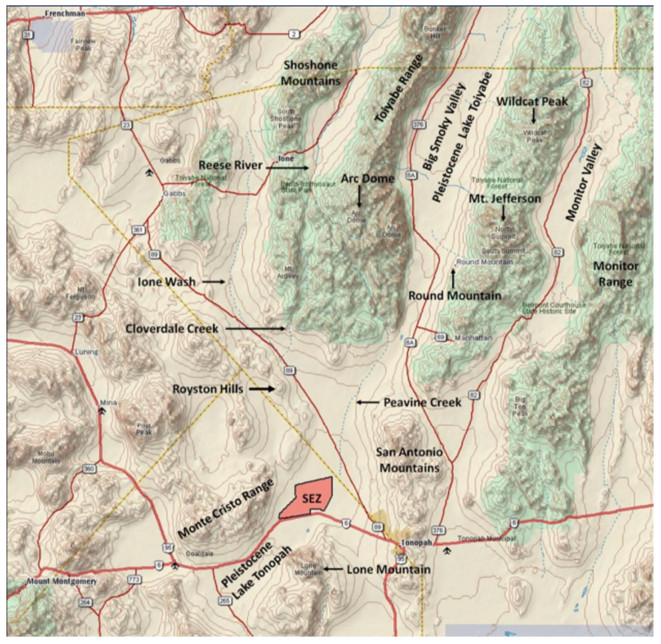1.
Introduction
This is an analysis of Native American interpretations of where they lived and what they did in the late Pleistocene. The analysis is focused on lands near Death Valley, California, and Las Vegas, Nevada, that are a part of the Southern Paiute Creation Lands. These lands are the homelands for regional Native Americans and these places mark events never to be forgotten. According to one Southern Paiute elder [1]:
I think that the geography of the area is unique in that it's part of how the story of Creation talks about how this was at one time all underwater. When the water started to subside you got these big, huge lakes, and that's where a lot of those animals used to be here, however long ago, in the very beginning. A lot of the things that were placed there were put here for a reason so all the different rocks and things that you see, everything that's out in this landscape, including all the geology, is very much alive. It is things that we use, we rely upon; it talks to us, we talk to it. It's things that help get you through your life. This geology is central to all of our songs and our stories, even when we're talking and singing Salt Songs, Silver Songs, and other types of songs or even prayers. It's the same way that we have the vocal snapshots during those songs – things that describe all of this and how lush it truly is as an environment. There is just so much that's out in this area that is alive and needs that continuous interaction that can't be disturbed in the way that it's been placed here.
This analysis discusses the cultural implications of bringing Native American voices into academic and land management interpretations of Native life during the late Pleistocene and early Holocene periods. These discussions have already begun, for example, with the establishment of a Native American presence in the American Southwest from 22,000 years ago at White Sands National Park in New Mexico [2,3], and from 37,000 years ago in a deposit interpreted as a mammoth kill site on the Rio Puerco, New Mexico [4]. These new science findings have broken the Clovis glass ceiling that has otherwise dominated the discussion of the Native American past in North America for more than 75 years.
A new perspective now is possible with the scientific breaking of the Clovis glass ceiling. Now the co-residence of Native Americans, large Pleistocene animals, and the flora of massive wetlands is documented. Such large Pleistocene animals resided throughout this analysis' study area near Death Valley, California, and Las Vegas, Nevada, and were remembered by Southern Paiute and Western Shoshone people and discussed in ethnographic interviews that took place over decades of research. We argue, based on these 404 interviews, that Pleistocene locations and their ecologies containing lakes, rivers, and wetlands have been remembered and are celebrated as Heritage Landscapes by Native Americans today.
This essay also contributes to what archaeologist Bonnie Pitblado [5] terms rehumanizing the Pleistocene people of the Western Hemisphere, which she maintains is necessary because archaeologists have largely failed to understand and use the intellectual, emotional, and social lives of the Paleo Indigenous people they study. Pitblado further asserts the importance of understanding and using these dimensions of life in scholarly work because they are what made Ice Age people just as fully human as modern-day people are today. The current analysis argues for such a re-humanization that extends Native American oral history back to the Pleistocene (Figure 1) and places them as humans back in those times (Figure 2).
1 The cover art was produced by artist Karen Carr for White Sands National Park. It is an artistic interpretation of the lives of Native Americans 22,000 years ago during the Pleistocene Era. Her art provides a glimpse into what daily life looked like across the Southwest during this time. For more about Ms. Carr and her art, please see her website: www.karencarr.com.
The Clovis glass ceiling (also known as the Clovis first theory) was the dominant interpretation of the past throughout most of the 20th century and into the 21st century [6]. It precluded the acceptance of Native American Pleistocene observations as they were presented in Native rock paintings, rock peckings, and oral history that depicted and interpreted large Pleistocene animals and glacial wetland ecology [7,8,9]. During this time, it was the standard practice of western scholars and land managers to reject Native interpretations of ancient times. Pleistocene-specific observations were even removed from ethnographic reports by land managers and debunked in science papers and journals because Native American observations did not align with what western scientists deemed to be true.
For most of the 20th century, formal federal land interpretations in signs and museums would not consider the presence of Native Americans beyond the early Holocene, and even this understanding of early Native presence only occurred in a few cases, such as when mammoth bones were found associated with Clovis spear points from the San Pedro River in Arizona. A few Clovis dates did inch up to about 12,000 BP in the 21st century, but each observation was intensively challenged because it strained the long-established credibility of the archaeology community [10]. Even now, the clearest evidence of late Pleistocene occupation only is allowed by western scholars to have occurred between 11,000 BP and 13,000 BP, although Malotkie and Wallace [11] suggest some might have pre-Clovis dates. Their interpretations of rock peckings of Pleistocene animals along the San Juan River and review of more than a dozen other similar cases [12,13,14] are just a few examples among many of the movement that is occurring within scholarly communities to push against the limitations of the Clovis glass ceiling. Despite the strong cases argued by scholars like Malotkie and Walace and the Pleistocene observations made by Native Americans, the Clovis glass ceiling has become a dogma that is regularly taught in universities, supported by new data to the exclusion of non-supportive findings, and used by the academic community and land managers [2,7].
2.
Background
Native Americans maintain, based on their epistemologies, that culturally significant topographic places have always been important because they were defined that way at Creation, when the elements of the Earth were given agency and purpose. Navajo people, for example, say that all Earth Elements are alive, with people being called the five-finger humans [15]. Additionally, Shoshone elders participating in a Department of Energy study asked that one of the cultural landscape reports be entitled Dá Me Na-Nu-Wu-Tsi: Our Relations (Around Us) All of Mother Earth [16], a title that makes a direct nod to Native epistemologies on the agency and purpose of the Earth and its elements. Furthermore, an energy force, often called Puha in Numic languages, is a part of the Creation-defined purpose of places, fauna, flora, and humans and their relationship with all other elements. So, places and their elements are understood by Numic-speaking peoples as being alive since Creation, having cultural meaning today, and having always been central in the lives of Native Americans.
Since arriving in what they called the New World, non-Natives have asked questions and formulated answers about the land, the climate, the fauna, the flora, the people, and, of course, the collective history and purpose of these Earth Elements. As conquerors and colonial managers, non-Native Americans controlled how these questions were framed and interpreted and how the data were used to seek answers and frame social and land management policies. This process of intellectual control by the colonial scientists influenced and continues to have agency over the interpretations of the origins of Native Americans and thus the destiny of all of these Earth Elements. A new book, Native Science and Indigenous Knowledge [17], argues that Native people do know about the land and their cultural past with high confidence levels.
Vine Deloria [7], a Native American tribal member, scholar, and university professor, wrote a polemic regarding this issue entitled Red Earth White Lies in which, as a lawyer and recognized cultural spokesperson, he stipulated that when Native elders express their traditional ecological knowledge and oral history, they are to be considered right until others bring stronger data-based arguments against these positions. The book presents Native observations and interpretations regarding Pleistocene ecology and megafauna, volcanic eruptions, and the presence of larger and smaller beings. Critics argued that Deloria's argument failed to meet the western colonial definitions of how to get to the truth [18,19,20]. In critiquing Deloria's work this way, however, the critics did not address whether Deloria's claims were true given the Native ways of knowing and establishing the truth. Instead, they argued that there is no Native truth unless it is supported by western truth—an argument that only further validates Deloria's claims that Native American knowledge and history are being suppressed by the limitations of western science.
3.
Methods
The ethnographic studies, which are the foundation of this essay, were all funded by United States federal land management agencies such as the Bureau of Land Management, Forest Service, Fish and Wildlife Service, Department of Energy, and Air Force. Each agency funded a Native American ethnographic study to assess potential impacts to cultural resources by a proposed agency action, as required under the U.S. National Environmental Policy Act. These such ethnographic studies are referred to as Environmental Impact Assessments (EIA).
Culturally affiliated Native American tribal governments were contacted by the involved federal agency, informed about the potential development action, and asked if they desired to participate in the study. If they wished to participate, they were briefed about the research plans by a team at the University of Arizona headed by Richard W. Stoffle. Each of the tribal governments and cultural offices were provided with a schedule of field activities and asked to provide a list of official cultural representatives who would participate.
After the field work was completed, a draft chapter of findings was provided to each representative who participated. An additional copy was also made available to the participating tribes' cultural offices. Only after tribal review and approval are assessments provided to the sponsoring federal agency for consideration and inclusion in the official EIA regarding the proposed development project.
At the start of the study, the federal agencies agreed to publish the tribal evaluations following the tribal review and approval process. Once approved by the tribal representatives and their tribes' cultural resources departments, no further changes to the chapters were allowed. All tribal texts were intended to be public to be used in the EIA. We have published a detailed discussion of our methodology in various places (for more information see [21,22]).
The ancient springs evaluated by this analysis are located in five hydrological systems (Figure 2): the Las Vegas River, Amargosa River, Ash Meadows, Spring Mountains, and Sheep Mountains. As applied in this analysis, the term "river" is used to denote the status of the primary water system in each area from the late Pleistocene until the late Holocene. All hydrological systems are arid today but have ephemeral streams and artesian springs. Many modern-day hydrological systems are ephemeral due to dewatering by ranching, residential populations, and mining since 1900 AD, so the Native understandings of how these hydrological systems looked and functioned primarily derives from oral history and temporally deep cultural memories.
3.1. The springs have a surrounding heritage landscape2
2 According to the IUCN (2014), cultural landscapes are seen as "cultural heritage" in the framework of the World Heritage Convention, yet they have considerable overlap with one of the heartland issues of nature conservation, the global coverage of protected areas. Recent research reveals the overlaps and synergies between World Heritage cultural landscapes and IUCN's global category system for recognizing protected areas and some of the possible implications.
In 1908, German geographer, Otto Schlüter, defined two forms of landscape: the Urlandschaft (original landscape), or a landscape that existed before major human-induced changes, and the Kulturlandschaft (cultural landscape), or a landscape created by human culture. Schlüter argued that the major task of geography was to trace the changes in these two landscapes.
Shortly after in 1925, Carl Sauer, an American geographer and professor at the University of California at Berkeley, wrote in the Morphology of Landscapes that cultural landscapes are made up of human forms and actions superimposed on physical landscapes. He was probably the most influential in promoting and developing the idea of culture as a force in shaping the visible features of the Earth's surface in delimited areas. Within his definition, the physical environment retains a central significance as the medium with and through which human cultures act [23]. Sauer maintained that objects which exist together in the landscape exist in interrelation. He famously defined cultural landscapes as being "fashioned from a natural landscape by a cultural group. Culture is the agent, the natural area is the medium, the cultural landscape the result" [23].
Since Schlüter first formally used the term and Sauer effectively promoted the idea, the concept of cultural landscapes has been variously used, applied, debated, developed, and refined within academia. By 1992, the World Heritage Committee elected to convene a meeting of landscape specialists to advise and assist redrafting the Committee's Operational Guidelines to include "cultural landscapes" as an option for heritage listing properties that were neither purely natural nor purely cultural in form (i.e., mixed heritage) [24].
Cultural landscapes are identified and protected by the United Nations (UN) and the International Union for Conservation of Nature (IUCU) as heritage landscapes and places (Smith 2013). For a recent perspective on heritage landscapes, see the open access book A Research Agenda for Heritage Planning [25]. The concept of a "heritage landscape" implies both natural and cultural components combined over time to produce a phenomenon that is clearly located somewhere and can be considered for identification and protection by contemporary nations and world government organizations [26,27]. Native Americans argue further that their traditional heritage springs are still alive despite being dewatered and engineered. They argue that the springs and surrounding heritage landscapes contain the songs, prayers, ceremonies, and memories of their ancestors who have lived there since Creation. One Native American representative spoke to this ceremonial quality of springs when he said [28]:
The mountains were significant because water comes from the springs that are there. Water is the most important thing. The mountains would have been a good place for hunting. Different kinds of plants are found at different elevations. They mostly had ceremonies in the canyons. But down in Big Smoky Valley, they had ceremonies down on the flat, right where there's a spring.
Over the period of three decades, more than 404 ethnographic interviews were conducted by ethnographers and representatives of culturally affiliated tribes (Table 1) in the study area around Death Valley and Las Vegas (Figure 3) at 25 ancient heritage springs. The table presents hydrological systems where springs are located, names of the springs, ethnographic reports produced by the study (all of which are listed in the bibliography), the number of tribal representatives interviewed at each spring, and the total interviews for all studies. Some people were interviewed with multiple survey instruments designed to understand different cultural dimensions of springs. Tribes from three ethnic groups (Western Shoshone, Southern Paiute, and Mojave) participated in the various studies.
The analysis of these heritage springs studies presented in Table 1 [29], one of which is illustrated in Figure 4, document the cultural variables that make artesian springs attractive to Native Americans. These variables include (1) having high quality water, (2) having a steady supply of water, (3) having a wide spatial breadth or horizonal distribution of spring water that produces many shallow wetlands, which then provide habitat for plants, animals, and migratory water birds, (4) supported a residential Native farming community, (5) being on a pilgrimage trail to a sacred destination, and (6) being associated with a culturally important person or event, such as the Southern Paiute High Chief, Chief Tecopa. Culturally attractive springs have many or all of these characteristics, and their contemporary cultural centrality varies based on the number of variables and the quality of the variables.
The following analysis of Salt Creek Spring and its larger heritage landscape identifies only a few of these variables that are meant to indicate what is an attractive artesian spring, most of these variables are of poor quality and limited quantity. Based on the criteria of the variables used by this study, Salt Creek Spring should be an example of a culturally unattractive spring; however, past ethnographic studies in the area have established Salt Creek Spring as a prominent place of traditional ceremonial use. This analysis thus asks, despite its evaluation as a supposed culturally unattractive spring, why is this spring and its heritage landscape so valued for Native Americans today?
4.
Salt Creek Spring and the heritage landscape3
3 Sources for this text were the official tribally appointed by the American Indian Transportation Committee (AITC) who assessed the potential impacts of transporting low-level radioactive waste along highways in Nevada and California (AITC 1999) and the National Park Service funded the Old Spanish Trail study (Stoffle 2008).
Once it is understood that the Native Americans involved in our studies consider all springs to be culturally important since Creation, there remains the question of why the simple and isolated Salt Creek Spring is perceived as not only important, but also culturally special. Today, it has a lower flow than most springs in the region. The fauna and flora are neither as abundant nor as diverse as they are at other springs in the region. Salt Creek Spring's water appears never to have been an irrigated farming area and is undrinkable due to its high concentrations of both sodium and magnesium sulfates.
The temporal frame for this analysis is operationally defined as the late Pleistocene that occurred between 128,000 BP and 11,700 BP and the Holocene that occurred from 11,700 BP to modern times. Scientific studies such as those referenced earlier in this essay have placed Native Americans in the region at 37,000 BP, indicating that Indigenous Peoples experienced this area as both a massive wetland filled with lakes, rivers, swamps, and, later, as an arid desert with intermittent streams, sand dunes, and small artesian springs. Native American groups like the Southern Paiutes and Western Shoshone remember these periods of both extreme wet and dry, and they tell oral histories and have peckings on rocks and dark colorations on mountain sides which represent the giant birds, mammoths, and sloths of the late Pleistocene. During an ethnographic study focused on this study area, a Western Shoshone representative said [1]:
This [Amargosa River] was a major river. It had to be to fill up Death Valley and make it a lake [Lake Manley]. The wetter times with elephants and mastodons, that's been talked about by our elders. These are the people that hardly ever went to school; they didn't learn it in school or anything like that.
Salt Creek Spring and its heritage landscape are especially important because they exist at the major western bend of the Amargosa River where it flowed into and largely produced Lake Manley in Death Valley (Figure 5). Here, by 18,000 years ago, was a high stand of Lake Manley. Upriver was the wide, but shallower, ancient Lake Tecopa that filled with sediment over thousands of years during the late Pleistocene. At about 159,000 BP, Lake Tecopa breached its dam, which was largely washed away. The resulting flood produced much of what is today called the Amargosa Canyon and subsequently began a primary input waterflow into Lake Manley in Death Valley. After the dam breach, Lake Tecopa [40] continued to have wetlands, artesian springs, and ponds which were used by large mammals like Equus (horse), Camelops (camels), mammoths, and muskrats. Additionally, following the lake's dam failure, the land became more arid, and the wetland environment was slowly reduced in size to, at first, a series of ponds and smaller wetlands and then to an arid sandy playa traversed by the Amargosa River. Massive sand dunes resulted from windstorms, although new studies document Dumont Dunes in place long before Lake Tecopa.
According to Southern Paiute epistemology, Big Dune, Eagle Mountain, Tecopa Hot Springs, and Dumont Dunes are prominent landscape features located along the Salt Song Trail (Figure 6), a spiritual trail to the afterlife. The Salt Songs are performed during the Cry Ceremony, which is conducted to guide the soul of a deceased person to the afterlife [1]. The location of the spirit person traveling the trail to the afterlife is marked at the end of each set of songs. The living people singing the Salt and Bird Songs know of the spirit's progress because each song notifies the living that the journey to places along the trail—and ultimately to the afterlife—has been successful [41].
Indian people say that the Salt Songs are about a journey that involves the physical movement of things as well as the movement through spiritual places into other dimensions. While on the journey, a person's spirit will visit a sacred site and then travel to the next one along the song trail. The song demonstrates the strong personal connection that a person has with the land, elements, and resources. When the songs are performed by the members of their community, the connection is made. For Paiute people, the song is about healing, ceremony, and reconnection.
4.1. Salt Spring and Avawatz Mountains heritage landscape
The Salt Creek Spring and its heritage landscape are on the Salt Song Trail as it passes along the Amargosa River and continues farther south into the Mojave Desert. Some key features of the Salt Spring heritage landscape are presented in Figure 7, including the Pleistocene Lake Tecopa, Tecopa Hot Springs, Dumont Dunes, Salt Spring, Avawatz Mountains, and the bend into Pleistocene Lake Manley in Death Valley. These are located at the hydrological head of the Mojave River.
This heritage landscape is recognized as a part of the Bureau of Land Management's Salt Creek Hills Protected Area. The spring and wetland in this area are sustained by water from the Salt Spring Hills and Avawatz Mountains and produce an area of critical ecological concern managed by the BLM (Figure 8).
According to one tribal representative:
Because of the mesquite trees and the location, Indians gathered there for ceremonies. The mountains constrict the stream and the acoustics of the place make it a desired site for various activities. It is a charming location. Indians use mesquite for food, shelter, and fire (fuel). Roots are used for making cradle boards; we use roots for handles of the musical instruments and handles for the gourds. In terms of medicinal usage, people chew mesquite leaves to treat bee stings. It is an essential item for the Paiutes and Mojaves. This site also has abundant water. Water runs year-round and it is a permanent source of water. On top of the Salt Spring Hills, you get good views of the surrounding area. A good view is used for communicating with supernatural beings and conducting prayers. The acoustics also play an important role in the significance and interpretation of the site [37].
At Salt Spring, a member of the AITC (American Indian Transportation Committee) research team was greeted by a whip-poor-will (Phalaenoptilus nuttallii) bringing a message [37]. The whip-poor-will was acting in an unusual way, according to a Paiute representative. The representative observed this behavior as an omen. The Chemehuevis have a phrase when they recognize an omen such as this. They treat it like a greeting by the whip-poor-will—"it is time to take out your gourd and start singing a song. It is usually a messenger. If it was a disturbed spirit, it is an owl. You have to talk to it." Another member of the AITC team said [37]:
I see the area as a refuge, an area where people go to renew themselves and cleanse themselves. Someone will climb on a hill and look out for intruders because the person cleansing themselves and talking to the Mountain could not be disturbed and would need privacy. The presence of that bird [whip-poor-will] reinforces the significance of the site. Things that come to the Indian are real heart.
The spring and its stream water are related to the Avawatz Mountains, Salt Spring Hills, and the singing sand dunes called Dumont Dunes. Tribal representatives agreed that the Avawatz Mountains were a traditional landmark between Southern Paiutes and the Kaweets (the Desert Mojave) peoples. According to one AITC member, twenty years ago, he went down there with a Paiute elder. The Kaweets no longer resided in the area then, and so the elder thought they had died out. The Avawatz Mountains are traditionally sought out for vision quests and healing.
Talking about the ceremonial uses of the Salt Creek Spring landscape, a representative explained that in the way of the Chemehuevi Paiutes, if a shaman performs a ceremony, he would go to the river, smoke himself, refrain from eating salt, and cleanse himself. When shamans went into their healing, they would put themselves into a trance and start singing songs without knowing it. The shaman would even sing songs he did not know and would talk as if possessed by a spirit. The shaman did not have the power originally; rather, the power was given to him through a creative force, and the shaman knew how to call it to him at the time of the curing. The curing power could come from an animal, rock, or something in the air, but a person's fingers can feel it and it goes through that person. This channeling of curing power is called the "laying of hands."
According to one ethnographic interview, after a shaman conducted a healing ceremony, he would take away inside of himself the sickness of the patient and so he had to go somewhere and cleanse himself. He may go to a river or a place of refuge like the Salt Spring Hills. There, he would spend a few days cleansing himself:
The Avawatz Mountain is a place where a person could go to find a spirit helper. He would use the Salt Spring Hills site to clean himself before going into the hills. The mountains contain spirit helpers who live on the mountain—each doctor has a different animal or natural force that helps him (like the wind, rain, or clouds). The doctor would call upon the mountain from time to time to help him find the proper medicine for a ceremony and the power to heal during a ceremony. These ceremonies could include individual sickness as well as a group [37].
The springs on this mountain that are associated with the Avawatz Mountain, including Salt Creek Spring, would be especially important because of their proximity to a power place:
Power spots usually are in the center of a people's territory. But this powerful mountain is at the boundary of three ethnic groups (Shoshone, Kaweets, and Southern Paiutes). Maybe it was a jointly used powerful mountain like Spirit Mountain (possibly the Kawaiisui). The current name of the mountain, Avawatz, suggests a meaning of a place of many spirits. In Chemehuevi, the word Avawatz means "many" or "many spirits." This may further refer to the many spirits there and reflect the Mountain being used by these three Indian ethnic groups. The Salt Song Trail passes through this area [37].
4.2. Salt Spring in a heritage landscape
Despite its initial evaluation as being an unattractive spring, Salt Creek Spring is clearly a special and sacred place for reasons related to both its existence in and of itself as well as for its connections to a larger heritage landscape. Its sacredness to Native Americans in the region has been established since the late Pleistocene and early Holocene, when the landscape would have been experienced as a massive wetland full of elephants, mammoths, giant birds, camels, and sloths. These times are remembered by Indigenous populations through their oral histories and rock peckings—records of preserved knowledge that are now being corroborated by recent developments and findings in western science.
With its location at the major western bend of the Amargosa River, where it once flowed into Lake Manley and Death Valley, Salt Creek Spring sits at an especially important place on the landscape. During the late Pleistocene, the spring sat just downriver from shallower Lake Tecopa—a waterbody remembered in deep time by Native oral histories—and near to large hills and dunes like the Dumont Dunes. Native Americans say that these dunes sing to the people. One elder spoke about this quality of the landscape being alive and sharing knowledge through the songs of Big Dune in the Amargosa Valley:
We were taught that these songs come in many different forms but are all tied to certain locations or activities mentioned within. Similarly, we know the land has songs that can be heard. In Amargosa Valley, there is a predominant sand formation known as Big Dune with important cultural significance. These dunes have eyes to watch over the land and a voice to share its messages in the songs that it sings and the stories it continues to tell our people ever since the beginning of time. It is only one of three locations in the Great Basin known to be blessed with a voice commonly known as Singing Dune. Culturally, we know these features are alive and have relatives in Tonopah and Fallon, Nevada, that must be protected and respected, as we have done for thousands of years [1].
The dunes in this area, as well as others, emit low-frequency sounds that are caused when moisture is found within the sand particles, the temperatures are high, and some sort of impact occurs that causes the sands to shift [43]. Even further, Dumont and other dunes from this area have been documented to make musical notes [44,45]. The phenomenon is common among sand dunes worldwide, and their singing has been recognized as early as the 13th century in the Gobi Desert [46]. For Native Americans, these singing dunes talk with people about the past.
A final feature of the Salt Spring, Creek, and Hills area is that it sits atop the hydrological system of the Mojave River, which flows south through Silver Lake and Soda Lake toward Baker, California, and then into the desert [47,48]. During extremely wet periods, Silver Lake water actually flowed north across the Salt Creek divide and into Death Valley. Ore and Warren [48] documented the following most recent chronology. A major lacustric interval ended about 14,500 BP, with water overflowing the Silver Lake outlet at the 941- to 943-ft level. A second lacustric event, which occurred from about 13,750 BP to 12,000 BP, caused extensive development of shoreline features at the same level. During the third high water period, from 11,000 BP to just before 9,000 BP, the outlet was cut to the 936-ft level. A final lake from 8,500 BP to 7,500 BP did not overflow the outlet. Lakes and wetlands predominated during these wet periods as they must have to the north in the lower Amargosa River region. Ore and Warren [48] also concluded that humans were apparently in the area at 10,000 BP. Enzel's research [49] documented Silver Lake and other areas, such as Ash Meadows, being much wetter between 4,000 and 3,000 BP and again at least five times during the middle and late Holocene including after the beginning of the Little Ice Age in 1300 AD. So, the greater region surrounding Salt Spring was periodically wet well into recent times.
Hydrological divides were traditionally used to define territory between cultural groups, and it appears that this site was such a defining place located between the Numic-language-speaking Shoshone and Paiutes of the Amargosa River and the Yuman-language-speaking Desert Mojave. The people of this upper Mojave River hydrological system (Kaweets) are also known as the Desert Mojave [50]. The Mojave River in the late Pleistocene and early Holocene was the center of a fertile valley. Silver Lake, Soda Lake, and Lake Mojave contained expansive shallow lakes surrounded by wetlands filled with birds, animals, and plants. The people of the upper Mojave River are detailed here because they are well known from the official accounts of early Spanish explorers and primary ethnographic studies.
In 1776, Garces found Serrano-speaking rancheria farming settlements along both sides of the Mojave River up to Soda Lake. In the 18th century, a zone of frontier interactions existed between four groups: the Chemehuevi Paiutes, the desert Kawaiisu (Nuwiwi), the desert Serrano (also called Vanyume), and the desert Mojave or Tiira'ayatawi [50]. The Chemehuevis interviewed during our ethnographic studies agree that at a minimum, the desert Mojave occupied the sinks of the Mojave and Soda Lake (6). Known Mojave River foods include acorns, which were a staple, but were supplemented by regular mesquite and screw bean mesquite, carrizo-grass sugar (produced by aphids on the leaves of phragmites or carrizo grass), and tule reed roots. Animals included cottontail rabbits and jackrabbits, desert bighorn and pronghorn sheep, and the desert tortoise [50].
The hydrological divide at Salt Spring probably was a cultural "interface center, " which, according to Bean [51], sustained hundreds or thousands of people living within a radius of 75 miles away. They would have participated in trade feasts, funerals, and World Renewal rituals [52].
This heritage landscape today is a mnemonic device for tens of thousands of years, during which this was a center of Native occupation located on massive freshwater lakes, rapidly flowing rivers, and extensive wetlands. The animals of this ecosystem were spectacular and involved large mammoths, ground sloths, horses, and large birds. For much of the later Pleistocene, the landscape also supported Native life. Even during the Holocene after the climate changed to hotter and dryer conditions, the landscape remained important to Native Americans. Places like Salt Creek Spring and Avawatz Mountains still are visited and serve to remind Native American people of the cultural heritage of this area deriving from tens of thousands of years of occupation.
5.
Ethnological discussion
A single study is useful for ethnography, but comparisons of cases produce ethnological findings that have more illustrations and higher confidence levels thus raising the confidence in the findings of a single case. To that end, we address briefly whether or not the case presented is unique or typical when compared with findings from the ethnographic assessment of the Bureau of Land Management Programmatic EIS regarding proposals to establish utility scale solar developments (Solar PEIS). These comparisons are discussed below.
Shoshone tribal representatives were asked during the Solar PEIS to officially evaluate the cultural importance of resources and places in the southern end of Big Smoky Valley, Nevada [28]. Big Smoky Valley is a north-trending basin within the Basin and Range physiographic province in south-central Nevada (Figure 9). The valley is roughly 567,700 acres and stretches 115 miles approximately forty-four miles east of the California/Nevada border, fifteen miles northwest of Tonopah, Nevada. The area is perceived as aboriginal Shoshone lands since the Pleistocene.
While many individual resources and historic events were identified as significant in the Big Smoky Valley, its land was identified as the Origin place for the Shoshone people. In ethnographic interviews, the Shoshone tribal representatives stipulated that because they have lived in these lands since the end of the Pleistocene and throughout the Holocene (or approximately 40,000 years), they understand the dramatic shifts in climate and ecology that have occurred over these millennia. Native American lifeways were dramatically influenced by natural shifts, but certain religious and ceremonial practices persisted unchanged. These traditional ecological understandings are carried from generation to generation through the recounting of origin stories occurring in mythic times and by strict cultural and natural resource conservation rules. The study involved American Indian tribal governments and their appointed cultural representatives participating in this Programmatic Environmental Impact Statement in order to explain the meaning and cultural centrality of the plants, animals, spiritual trails, healing places, and places of historic encounters that exist in these playa-centered lands.
During the late Pleistocene, the Big Smoky Valley was filled with a massive lake that was fed by rivers and drainages from surrounding wetlands. Marshes dominated the landscape because much of the land was inundated. One Shoshone elder remembered a wetter, late Pleistocene landscape:
Just up the valley, from talking with elders and stuff, that's where the Shoshone people started. That's their Creation point. From there, they dispersed out into the north, south, east, and west. That's where all the Shoshone came from, Smoky Valley, Monitor Valley. But then again, if we look at the stories, the people and the earth, they talk about a migration over water. We see that when the water skipper brought the coyote back with his little basket full of children that he made, they're coming over water. Maybe these archaeologists have it wrong when they say that the people walked on the land. In out stories, they talk about coming over on a boat. I guess it would be a boat, if you look at the analogies. Again, we're going back to the time when the animals talked, they conversed with each other, interacted with each other, and had ability to have children with each other. This is basically the Creation story, what I'm sharing with you. I listen to the Southern Paiute story and they talk about the Ocean Woman. You know, if you look at them, theirs is similar to ours, tied with the water. They're the same as us. They didn't come over walking, marching on the land like people think. They came over on the water. So we came over here in the time where this was all under water [28].
Although the climate has shifted, steams, seasonal playas, and springs still dot the landscape. Streams originate in the mountains and at the base of the surrounding mountains and foothills, and springs provide water and luscious landscapes. Water maintains an important cultural role in the lives of the Shoshone people. Natural water sources, called gwizho'naipe or life-producing water [53], play a large function in crucial rituals as well as day-to-day life.
According to one elder:
Smoky Valley stands out. The whole valley is connected. The sand dunes and White Mountains stand out. I'm from the mountains so the mountains stand out. I was raised in the mountains so I'm a mountain person. 10,000 years ago, there was a big old lake right here where we're sitting on [28].
The environmental assessment of Big Smoky Valley was one of nine study areas considered for large utility solar energy farms to be placed on playa lakebeds that were formed during the late Pleistocene [54]. More than 182 ethnographic interviews were conducted during these solar studies in Nevada and Utah [52]. Each proposal focused on a large playa and consultations, field work, and findings involved the review and approval of tribal governments. Tribal representatives each expressed deep knowledge of the now largely dry playas and that they represented a time when large lakes and wetlands filled the valleys and were the central homes of Native peoples. Cultural continuity back to the Pleistocene was expressed in these PEIS studies, which is similar to what happened at Salt Spring and Big Smoky Valley. The official tribal representatives who participated in the nine PEIS studies all identified the playa study areas as their ancient heritage. They uniformly have stories about the distant past including large mammals, lakes that filled most of the valley, rivers, major wetlands, and abundant fauna and flora. All of the Solar PEIS studies were reviewed officially by the involved tribal governments [52].
6.
Discussion
Salt Spring, Creek, and Hills are the center of an ancient cultural landscape that is best identified as being established in deep time and it continues today. This analysis of Salt Spring documents that some heritage landscapes have roots in time and contain components that are widely located in space. The analysis has illustrated these points with a temporal reconstruction back to the Pleistocene, a time when the area had deep lakes, fast rivers, massive wetlands, megafauna, and was the center of human activities. Spatial reconstruction at some level involves the Amargosa River and Mojave River, both of which, at various points in time, flowed into what is now known as Death Valley. In the past, Death Valley was a lush paradise and the home of Lake Manley and stable Native communities. Activities conducted at this location remain in the oral memories of Native people.
This analysis began with a description of the geographically and culturally unassuming Salt Spring and situated it in an ancient heritage landscape that remains culturally important to Native American tribes that have traditional ties to this area. In so doing, the analysis argues for the temporal and spatial expansion of heritage landscape studies to fit the lived experiences and social constructions of Native Americans. This expanded analysis potentially can contribute to their culturally valuated heritage landscapes and increase their national and world preservation.
The issue of how powerful national elites control the definition of time and landscape is raised, but not fully addressed, by this analysis. Muhammad Mughal's field-based research and social philosophy serve as firm beginnings for understanding this issue. In his article, "The Western and Non‑Western Dichotomization of Time" [55], he provides data-based descriptions of the intellectual footprint of colonial systems on the Indigenous knowledge systems of suppressed peoples. His work documents intellectual suppression of Native thought as a means of controlling conquered peoples. Mughal's findings [56] are like those of Jennings [57] who argues in the Invasion of America that colonial elites engaged and continue to engage in a systematic redefinition of the conquered people thus justifying their suppression; this is what he terms the Cant of Conquest and is the point of the polemic presented by Deloria in Red Earth White Lies.
Native Americans have deep cultural differences in perceptions of both time and space with Euro-American scholars, thus creating a natural resource management challenge called an epistemological divide [58]. The Amargosa River and valley, for example, are central to the lives of Native American tribes. It is believed that these lands were given to Native Americans by the Creator and have been under their care since Time Immemorial. Songs associated with the Amargosa Valley area came from the Creator so they could be sung to maintain balance in the world. Native Americans have always watched over and interacted with this land as there is a deeply rooted spiritual connection between them and the land. This connection weaves stories and songs into the landscape, which itself is alive and retains both music and knowledge of past events. Native Americans learn about the past by listening to singing sand dunes.
Although the environmental setting of the greater Amargosa Valley has changed dramatically over time, the Native American tribes from this heritage landscape have thrived and continue to do so. Countless shifts in the plant and animal communities and water availability have been met with constant co-adaptations. Traditional ecological knowledge is continually developed and maintained in balance with the natural setting. Ultimately, the sustainability of this heritage landscape is ensured through the implementation of thoughtful, active management as a part of the sacred ecology of Native Americans.
The Clovis glass ceiling, however, is not completely broken according to some scholars who continue to challenge the recent scientific findings and their implications. Johnson's summary of this issue highlights both the embeddedness of the concept and the academic commitments to the issue being true [59]. Johnson quotes an elder from the Acoma Pueblo: "It didn't bother me at first, but it's starting to really nudge at me, I guess you could say, 'how much more evidence do you need to say: we did exist back then. We've been in the Southwest region for a very long time'."
Use of AI tools declaration
The authors declare they have not used Artificial Intelligence (AI) tools in the creation of this article.
Acknowledgments
The authors would like to thank the U.S.A. Bureau of Land Management, the Department of Defense, the Department of Energy, the National Park Service, the Fish and Wildlife Service, and the United States Forest Service for providing research funding over three decades that made possible the various ethnographic studies used in this analysis. Most importantly, they would like to thank the Southern Paiute, Western Shoshone, Owens Valley Paiute and Shoshone, and Mojave tribal representatives who contributed the oral histories and ethnographic interpretations used in this essay.
Conflict of interest
Richard W. Stoffle, Kathleen A. Van Vlack, and Heather H. Lim are guest editors for AIMS Geosciences and were not involved in the editorial review or the decision to publish this article. All authors declare that there are no competing interests.
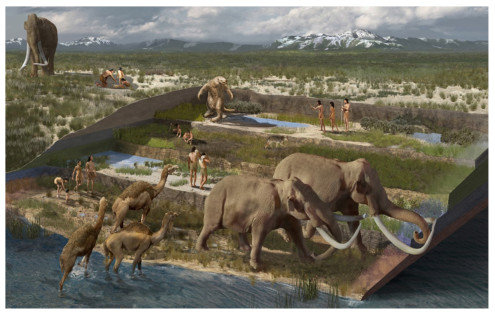









 DownLoad:
DownLoad:

